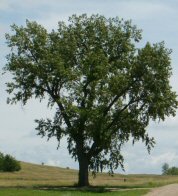Cottonwood
 Cottonwood (Populus spp. /Salicaceae). The
genus Populus (Cottonwood/Aspen/True Poplar Group) contains about
35 species native to Eurasia and North Africa, Central America
and North America. All species are identical at the cellular level.
Cottonwood trees can attain heights of 190 ft with diameters of
6 ft. Populus sapwood is white and Cottonwood (Populus spp. /Salicaceae). The
genus Populus (Cottonwood/Aspen/True Poplar Group) contains about
35 species native to Eurasia and North Africa, Central America
and North America. All species are identical at the cellular level.
Cottonwood trees can attain heights of 190 ft with diameters of
6 ft. Populus sapwood is white and  the heartwood
is light brown. The wood is weak and soft and can produce a sour
odor when wet. Tension wood occurs frequently and causes a fuzzy
surface when cut. Cottonwood does not work well and is nonresistant
to heartwood decay. It is used for agricultural implements, boxes,
crates, cutting boards, food containers, interior furniture parts,
lumber, plywood short bolts, pulpwood, veneer, and wooden wares. the heartwood
is light brown. The wood is weak and soft and can produce a sour
odor when wet. Tension wood occurs frequently and causes a fuzzy
surface when cut. Cottonwood does not work well and is nonresistant
to heartwood decay. It is used for agricultural implements, boxes,
crates, cutting boards, food containers, interior furniture parts,
lumber, plywood short bolts, pulpwood, veneer, and wooden wares.
http://www.fpl.fs.fed.us/documnts/TechSheets/HardwoodNA/pdf_files/popspeng.pdf.
Characteristics found in the Cottonwood (Populus spp.):
- Diffuse porous
- Simple perforations
- I/V pits medium to large (8-50)
- Homocellular, uniseriate rays
- R/V pitting foraminate or salicoid
WOOD SLIDES
Click on each image to view a larger
image.
|
| Radial section of Poplar (Populus sp.) showing a homocellular ray with foraminate or salicoid ray-vessel pitting on procumbent cells. |
   
   
CHARCOAL SLIDES
  
   
|



 Cottonwood (Populus spp. /Salicaceae). The
genus Populus (Cottonwood/Aspen/True Poplar Group) contains about
35 species native to Eurasia and North Africa, Central America
and North America. All species are identical at the cellular level.
Cottonwood trees can attain heights of 190 ft with diameters of
6 ft. Populus sapwood is white and
Cottonwood (Populus spp. /Salicaceae). The
genus Populus (Cottonwood/Aspen/True Poplar Group) contains about
35 species native to Eurasia and North Africa, Central America
and North America. All species are identical at the cellular level.
Cottonwood trees can attain heights of 190 ft with diameters of
6 ft. Populus sapwood is white and  the heartwood
is light brown. The wood is weak and soft and can produce a sour
odor when wet. Tension wood occurs frequently and causes a fuzzy
surface when cut. Cottonwood does not work well and is nonresistant
to heartwood decay. It is used for agricultural implements, boxes,
crates, cutting boards, food containers, interior furniture parts,
lumber, plywood short bolts, pulpwood, veneer, and wooden wares.
the heartwood
is light brown. The wood is weak and soft and can produce a sour
odor when wet. Tension wood occurs frequently and causes a fuzzy
surface when cut. Cottonwood does not work well and is nonresistant
to heartwood decay. It is used for agricultural implements, boxes,
crates, cutting boards, food containers, interior furniture parts,
lumber, plywood short bolts, pulpwood, veneer, and wooden wares.














